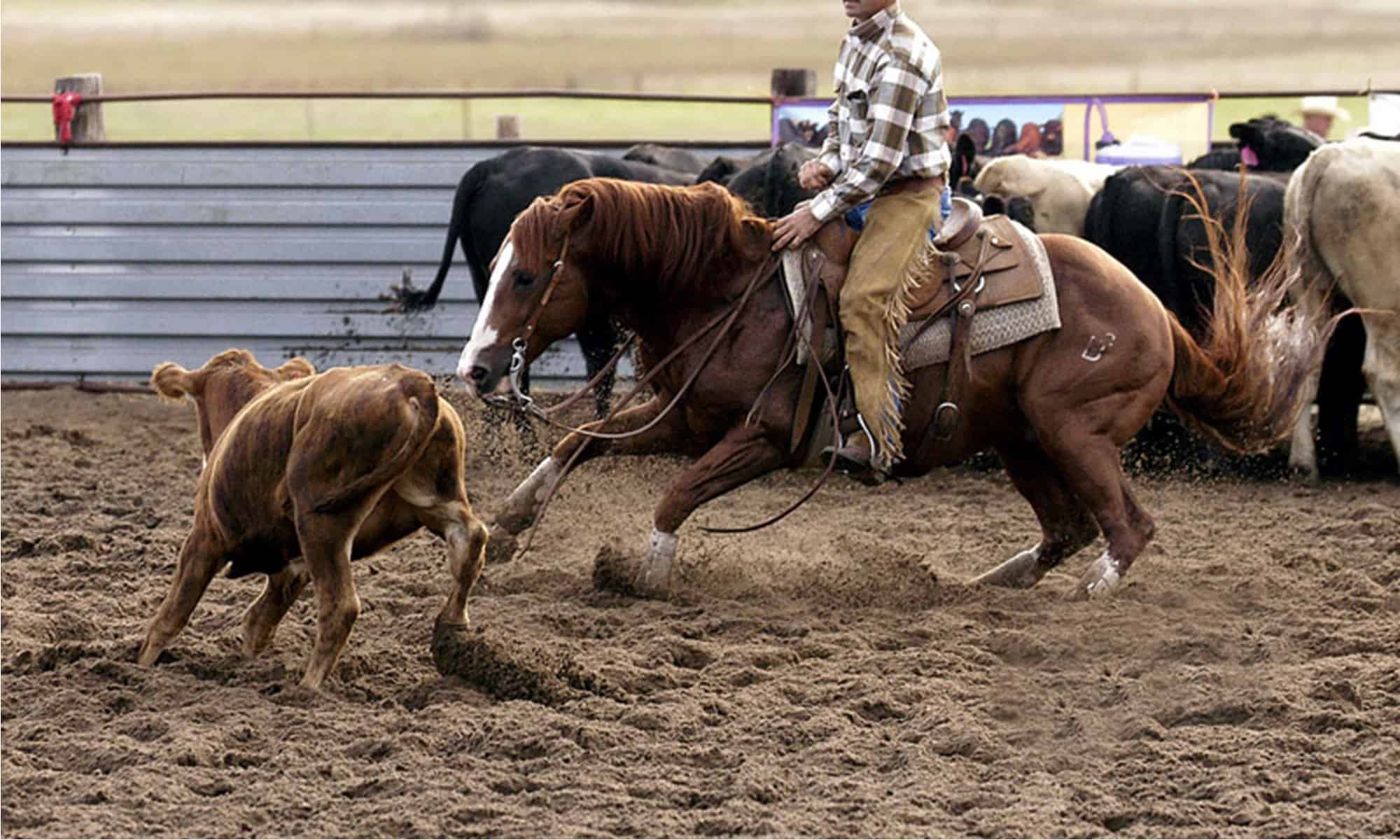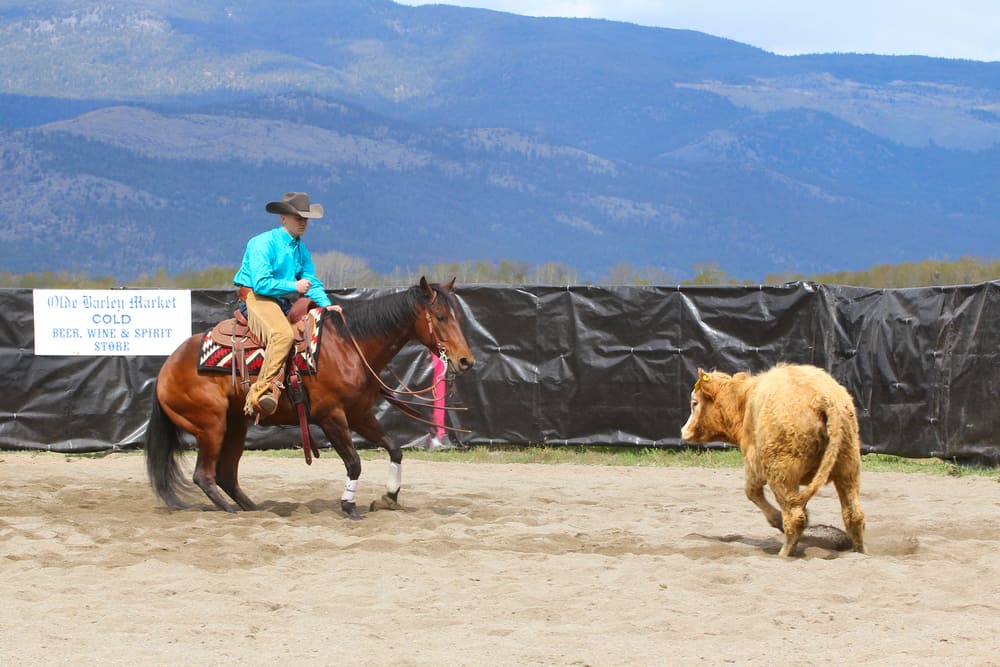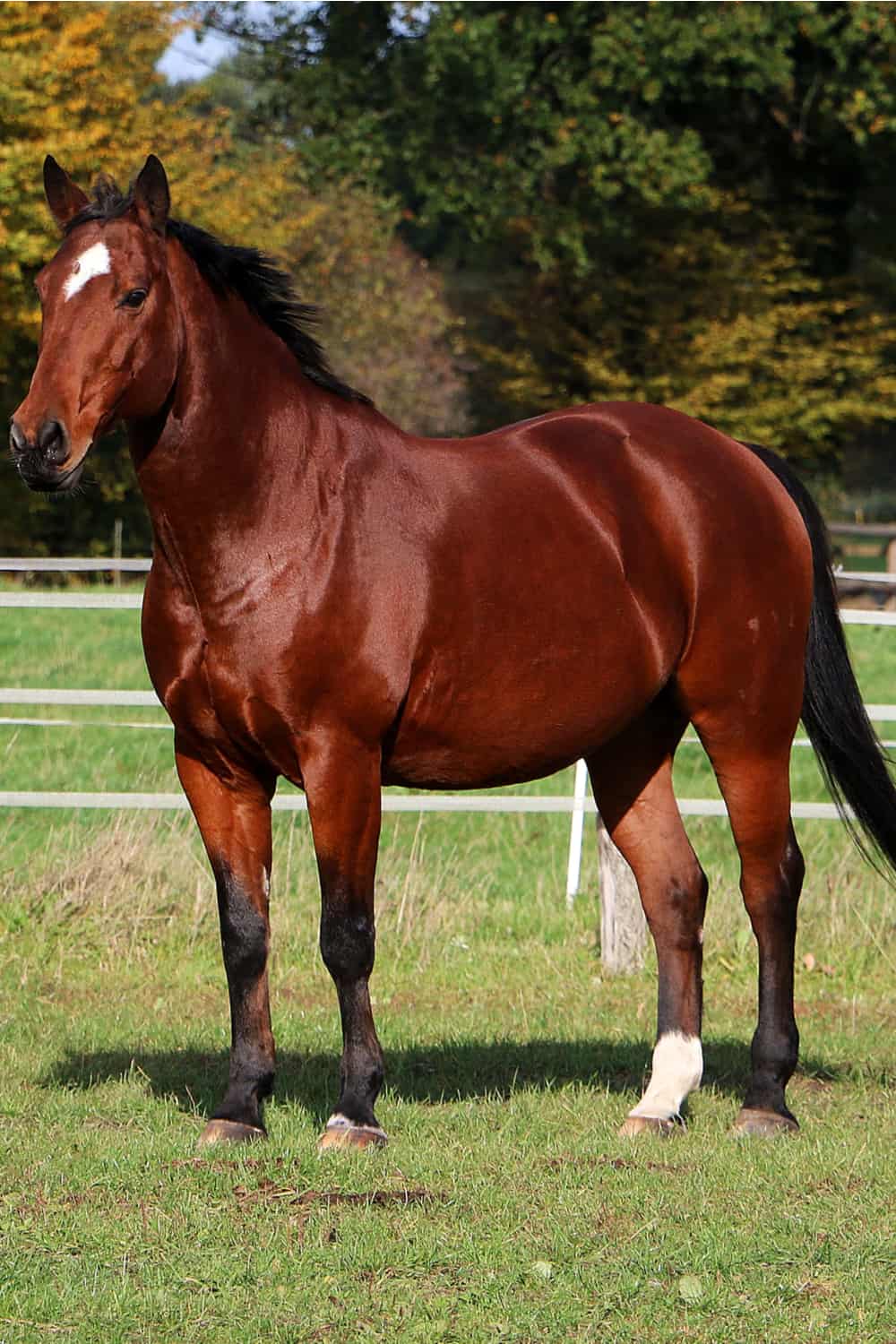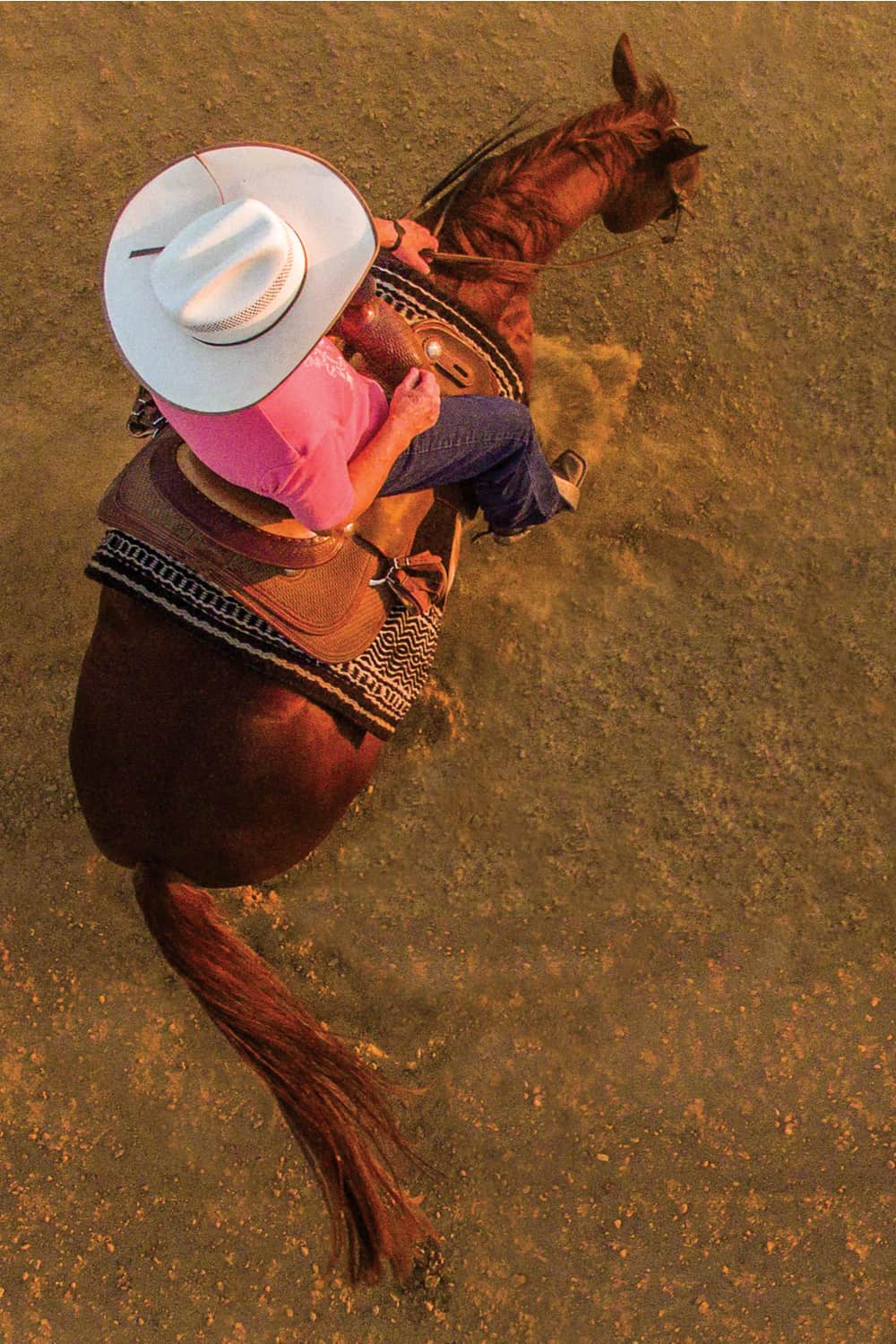There are many types of horse competitions around the world, but one that might not be widely known is cutting. In this type of contest, the rider uses a cutting horse to cut one cow from a herd and “hold” it in the center of an arena in a true battle of wills. The question that arises, though, is: what is a cutting horse?
Is it a specific breed or any horse trained for the competition purpose? Read on to find out more about it.
What Is a Cutting Horse?
A cutting horse is a stock horse – aka, a horse particularly suited for working with livestock, generally cattle, but also sheep – bred and trained for cutting, an equestrian competition that requires the horse and rider to separate a cow from its herd and keep it separated for a determined period of time.
To do that, the horse must possess strong “cow reading” abilities that allow it to anticipate and block the cow’s attempts to return to its herd.
Most cutting horses are bred from American Quarters. However, there are certain differences between a cutting horse and a race and halter quarter horse.
Cutting Horse vs. Race Quarter Horse: What Is the Difference?
American Quarter is a horse breed known for its outstanding racing abilities. The breed’s name, in fact, derives from the performance of these horses over short distances and their ability to outrun other horses in races of a quarter-mile or less.
The development of the breed can be traced back to the seventeenth century, and today, this is one of the most popular breeds in the United States. In fact, Quarters are so popular that the American Quarter Horse Association (AQHA) is the largest breed registry in the world.
In addition to their exceptional race abilities, Quarter horses are also particularly suited for ranch work and rodeo competitions. Moreover, Quarter horses are also used in English horseracing disciplines, including jumping, hunting, driving, show, dressing, and other equestrian disciplines.
Because of the breed’s versatility, different breeders focused on different characteristics. Selective breeding led to slight differences between the Quarter horses used for racing and those used for cutting, although they all share a similar appearance and temperament.
Racing and Hunter Type Quarter Horses
These horses are bred to sprint over short distances and are characterized by long legs and an overall lean yet muscular body. The stance often resembles that of Thoroughbred horses, which are classically used in English equestrian disciplines. They can grow as tall as 17 hands.
Cutting (Stock) Quarter Horses
Well-suited for working with livestock, cutting horses have a smaller stature, but they are still capable of quick and agile movements. The powerful hindquarters allow them to achieve great speeds over shorter distances while also maintaining a good speed when running in random patterns.
Most cutting horses stand between 14 and 16 hands tall, and have a general muscular appearance. The head is small and refined, with a straight profile and resting on a muscular neck. The body is also muscular with powerful, rounded hindquarters and a broad chest.
All coat colors are accepted; the most common is sorrel, a brownish-red similar to chestnut. Other common colors include bay, black, palomino, chestnut, grey, dun, red roan, grey roan, blue roan, perlino, cremello, and white.
The AQHA recognizes solid-color and pinto cutting horses – all pinto variations are accepted.
What Types of Horses Are Used for Cutting?
Most cutting horses are American Quarter horses. However, the competition also allows the use of other horses with American Quarter ancestry, such as American Paint horses. Other breeds of stock horses are also used, mainly in breed-specific competitions.
How Much Is a Cutting Horse Worth?
How much a cutting horse is worth depends on the horse’s age and any training it might have received. For instance, an untrained American Quarter colt or filly with good lineage and promising characteristics can cost anywhere between $2,500 and $10,000.
However, elite horses that have a good competition record are much more expensive. You can expect to pay around $25,000 for such a horse. Stallions can cost even more, up to $100,000.
On top of these costs, you must also consider maintenance and training costs, which can go up to $1,000 per month for boarding and vet alone.
While it’s hard to say how much a cutting horse is worth, know that recently, a cutting horse in Fort Worth was sold for the whopping amount of $1,050,000.
How Long Does It Take to Train a Cutting Horse?
How long it will take to train a cutting horse depends on a number of factors. The first thing to consider is whether the horse has been trained before. It is often easier to work with untrained horses, especially if the filly or colt was not originally trained for cutting.
This happens because a partly trained horse may have developed nasty habits that have to be dealt with before passing to cutting training.
Another factor is the horse’s natural ability to manage cattle. It generally takes at least four-five months of show training before starting with cutting training. To have the horse competition-ready, it might need about 12 to 18 months of solid training.
From this moment on, the horse will need at least six to eight months of show experience to get solid and reach its full potential, so you’re looking at about three years of training.
How Much Does It Cost to Train a Cutting Horse?
You can expect to pay around $1,000 per month for training, plus around $75 per hour for additional lessons.
Cutting Horse Myths to Debunk
Owning a cutting horse is expensive, but your investment and efforts could pay off if you train a champion. For instance, the National Cutting Horse Association pays out about $250,000 in money prize for the Open champion alone, with a total of money prizes awarded exceeding $1.8 million.
However, just owning a stock American Quarter doesn’t mean that you’ll win all that cash. Here are a few myths to debunk.
1. My horse’s bloodline is impeccable, so my horse is a champion
No, your horse is not a champion – but it could become one if you invest in training and maintenance. You should also check that impeccable bloodline more thoroughly. What were your colt’s parents or grandparents?
Were they cutting horses or race Quarters? Were there any common ranch horses with no noteworthy performance? Just because your colt is purebred doesn’t mean it has what it takes to win a cutting competition.
2. Training my horse for just six months is enough if the trainer is good
You can have the best trainer in the world, but your colt will never be competition-ready in six months. Preparing a colt for futurity takes at least 12 months if the horse has an innate ability to control cattle. More often than not, you’re looking at 18 months of training at least.
3. I just bought a trained cutting horse, and I’m going to take it to a show next week. It should do pretty well
Another common misconception is that you can show up at a competition with a trained yet newly bought cutting horse and expect a good performance. While it is true that cutting horses are trained to work on their own, the rider also influences the performance.
An inexperienced rider can cause the horse to make mistakes. For this reason, it is essential to train with the horse before joining a competition.
4. My horse loves chasing animals around, so he’s a great cutter
Does your colt love to chase animals, other horses, or people around the pasture? That doesn’t mean he’s a great cutter. The horse might only play – and numerous stock colts enjoy chasing other animals or people around. However, this doesn’t mean they will do good in a competition.
A few things to keep in mind is that in the pasture, the colt is chasing other animals without a rider on its back and without having to adhere to strict form and style rules. Thus, you should ask a coach or trainer whether the colt would make a great cutter.
5. My horse feels comfortable working with cattle, so he’d make a great cutter
We hate to spoil it for you, but all stock horses are bred to feel comfortable around livestock. Thus, the fact that your horse doesn’t mind a herd isn’t an indicator that he will ever make a great cutter. According to coaches and trainers, not having a reaction from your horse could even indicate that he won’t make a great cutter at all.
In fact, most great cutting horses display a strong reaction near cattle – either fear or aggression. Both reactions are easy to correct with the right training, but a horse that doesn’t show too much interest will most likely only make a good ranch horse.
Summary
Cutting competitions are fun, and training cutting horses could turn into profit if your colt or filly turns into a champion. However, remember that you’ll have to invest a lot of time and money. That said, you will surely be rewarded with the satisfaction of working with a horse.












you will spend a fortune in horses, equipment, time, entry fees, etc before you ever win a dollar let alone come close to having a champion cutting horse. there is no such thing as a diamond in the ruff., just try to win the daytona 500 with your dually truck
I agree with Lee, cutting horses really aren’t an investment they’re a passion. More like having kids, expensive, lots of work but once you have one you forget what life was like without them. Also need to remember unlike a quad or any other hobby you can’t just park it behind the shed when you lose interest or the weathers bad, they need the care and food just like kids.